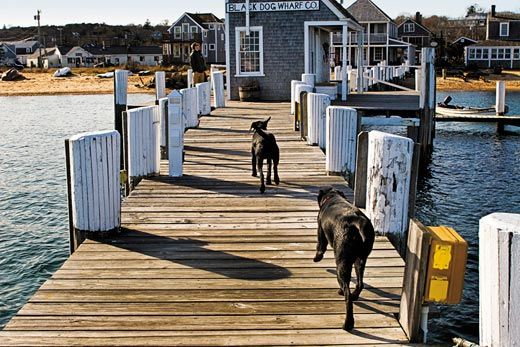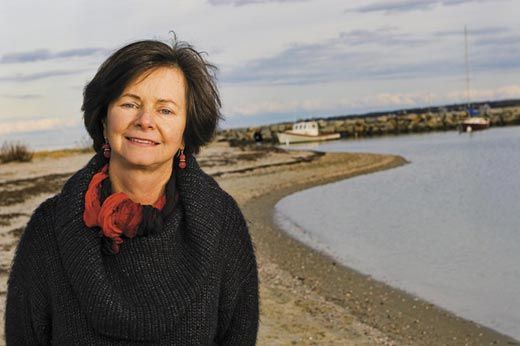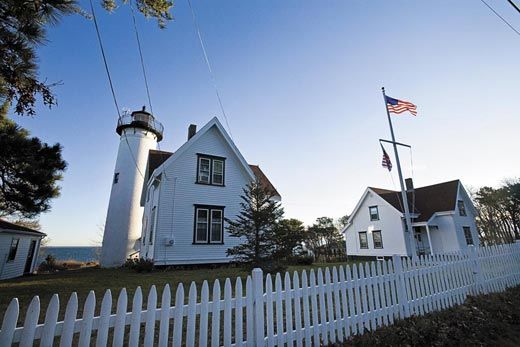The Vineyard in Winter
Pulitzer Prize-winning author Geraldine Brooks delights in the allure of Martha’s Vineyard’s off-season
/https://tf-cmsv2-smithsonianmag-media.s3.amazonaws.com/filer/Geraldine-Brooks-Owen-Park-Beach-631.jpg)
Here's what I love most about my town: its edges. In three directions, Vineyard Haven ends abruptly, as a town should, surrendering, gracefully and completely, to farms and fields and watery expanses of harbor and salt ponds. Within minutes, you can leave town behind and be lost on a woody trail, eye to eye with a ewe or out on the whitecaps with a sea gull.
Because of these edges and what lies beyond them, it smells good here. The breezes that blow through my kitchen window mostly carry briny scents, tangy with ocean. But when the wind shifts south, there might be rich dark smells of loam or hints of hay from newly mown fields. I love maritime things, so I also love the way it sounds here. On sultry summer nights, the foghorn from the West Chop Lighthouse lulls me to sleep with its low, rhythmic groan. In the morning, the three-blast warning from the departing high-speed ferry tells me it's 7:40, time to get to work. On still nights, with the bedroom windows open, I can hear the clink of the shrouds on the sailboats moored behind the breakwater.
If the island of Martha's Vineyard resembles a tricorn hat, Vineyard Haven is notched into the northern crease of its crown. It is not the oldest town here. (Edgartown, where the English first settled, is more venerable.) Nor is it the loveliest. (The gingerbread cottages of Oak Bluffs and the stone-walled, picket-fenced perfection of West Tisbury are more picturesque.) While the name "haven" these days conjures respite and idyll, for the hardy English colonists it meant simply "harbor," and replaced the even-more-to-the-point previous name penned on the earliest maps: Holms His Hole. The town, despite its tourist veneer, remains at heart a working harbor, a good, deep, sheltered place to dock a ferry, moor a boat. With its marine railways, corrugated-metal workshops and waterfront fuel-storage tanks, the town remains scruffy and scuffed, unmanicured. Real.
The island of Martha's Vineyard is two quite different places: summer and off-season, although those of us lucky enough to live here prefer to think of the demarcation differently: summer and secret season. Vineyard Haven, where the big white car ferries come and go, reflects this duality. In June, the cars coming off the ferry are stuffed with the paraphernalia of the summer house: extra blankets and cookware, kayaks on the roof racks and bikes lashed to the trunk. When I see these cars with their lumpy, bungee-corded extrusions, my heart lightens: summer's really here; good for the vacationers, I hope they have a lovely time. But by Labor Day, when the last laden cars line up to leave, I breathe the sigh of relief of the year-round resident. It's a sigh that ripples across the island like a collective exhalation.
In summer, the world is too much with us. Yes, it is quite fun to find yourself in line to buy leeks behind Jake Gyllenhaal or sitting down to dinner at the next table from Bill Clinton. But no one likes the traffic, the crowds, the sudden infusion of citified bustle and self-importance. There's an island bumper sticker that sums it up: Summer People, Some are Not!
After Labor Day, when the island is ours again, the volume drops as if someone's pressed the mute button. We don't have to wince at the car horn, sounded by some dolt unaware that island etiquette is to wait silently while the mom loads her kid into the car seat or her groceries into the trunk; while the two old geezers, cars abreast on a two-lane byway, pause to discuss last night's Red Sox game. You just wait. However...long...it...takes. There's a natural patience that comes from living on an island, where you learn that you're never totally in control of your schedule. Need to get to the mainland today? In this fog? Forget it.
Sometime in late September, the air turns cooler and the light changes with the lowering autumnal sun. Instead of summer's strong, buttery yellow light, there's a pale liquid radiance that pours slantwise across the bronzing salt marshes and kindles the crimsoning leaves of the beetlebung trees. In the early mornings, when I walk my dogs along the wrack line of the beach, the green twists of seaweed flare and glitter like strands of Christmas tinsel.
For me, raised up among friendly, laid-back Aussies and then dipped (for the decade we lived in rural Virginia) into the reflexive courtesies of the American South, it's been tough to adapt to the tight-lipped terseness of New Englanders. But I've been here long enough now to recognize it for what it is: Yankee thrift, a kind of prudent economy of expression. Just as no self-respecting Yankee would dream of wasting food or flaunting ostentatious wealth, few feel the necessity to waste words. So I've learned to get by without a lot of the social grease I used to need, because I now know that my neighbor who barely greets me day to day will be there in an instant if I ever really need him.
We do mind each other's business here, and we make no bones about it. In early spring, we gather in the elementary school gym for Town Meeting. Under discussion will be anything that requires the spending of our tax dollars. We'll vote to elect a fish committee to supervise the herring catch, argue about whether the dogcatcher should get a new office, or the harbor master an extra window to better watch over the port. Even though the moderator with her gavel is practiced and efficient, it can take three long evenings to get through all the warrant items. When I get up from the hard school bleachers, I wish there'd been a warrant item for the purchase of more comfortable seating. But my thrifty neighbors would never approve such a frivolous thing. As a relative newcomer—or wash-ashore, as we're called here—I love these meetings. It's where I begin to grasp the intertwining histories of families who have lived on this island since the 17th century, in the case of the English-settler descendants, and much earlier for the Wampanoag Indians who thrived here before the English arrived and who never allowed themselves to be displaced.
Most summer people never get to know Vineyard Haven. Most come here for the beaches, and the best of those are up-island, in Aquinnah, Chilmark, Menemsha. So they drive off the ferry and out of town, in haste to be elsewhere. A week or so later, on a rainy day, they might toil back down-island reluctantly, seeking groceries or a few Black Dog T-shirts as gifts for friends back home. While here, they might discover things they like: the Capawock Theatre, an old gem of a vintage cinema, recently reopened but still charmingly creaky and un-cinemaplex. Riley's Reads, a first-rate kids' bookstore where the proprietor can make spot-on recommendations. Midnight Farm, a wonderfully eclectic bit-of-everything emporium partly owned by the island's princess, Carly Simon. But other charms are more elusive to the casual visitor.
Vineyard Haven doesn't announce itself. You have to know that William Street is the place to find the wonderful Colonial, Victorian and Greek Revival houses that were not taken out by the fire that scorched the old town center at the turn of the century before last. And if, like me, you're a cemetery buff, Vineyard Haven has some of the best. When the winds are too raw and blustery for the beach, I walk my dogs to the graveyards and commune with the island dead. There's a lovely little old cemetery up by West Chop, where some of the many writers who've loved this town are laid to rest. William Styron and Art Buchwald are there, and John Hersey. (Lillian Hellman, whose house was here, is buried up-island, as is John Belushi.)
The larger town cemetery is on a rise of land well back from the harbor. It's a leafy place, with a lighthouse-shaped memorial to sailors. Nearby, a newer monument moves me each time I pass it: a simple granite plinth, inscribed with a Star of David and a Christian cross, the names of two men and their dates of birth and death. On one face of the plinth, two circles interlock. Underneath, the words: "Since 1958." The churchyard on Center Street has some of the oldest gravestones: wonderful Puritan names such as Experience and Thankful and creepy little skulls to remind us what's in store.
For many years, I was one of the many summer visitors who dreamed of moving here. I credit a graveyard visit for focusing my mind on the need to organize my life so I could actually do it. The inscription that inspired me was succinct and to the point. It read: "At last, a year round resident."
Geraldine Brooks' most recent novel, People of the Book, is now available in paperback.
Planning Your Next Trip?
Explore great travel deals
Smithsonian magazine participates in affiliate link advertising programs. If you purchase an item through these links, we receive a commission.


